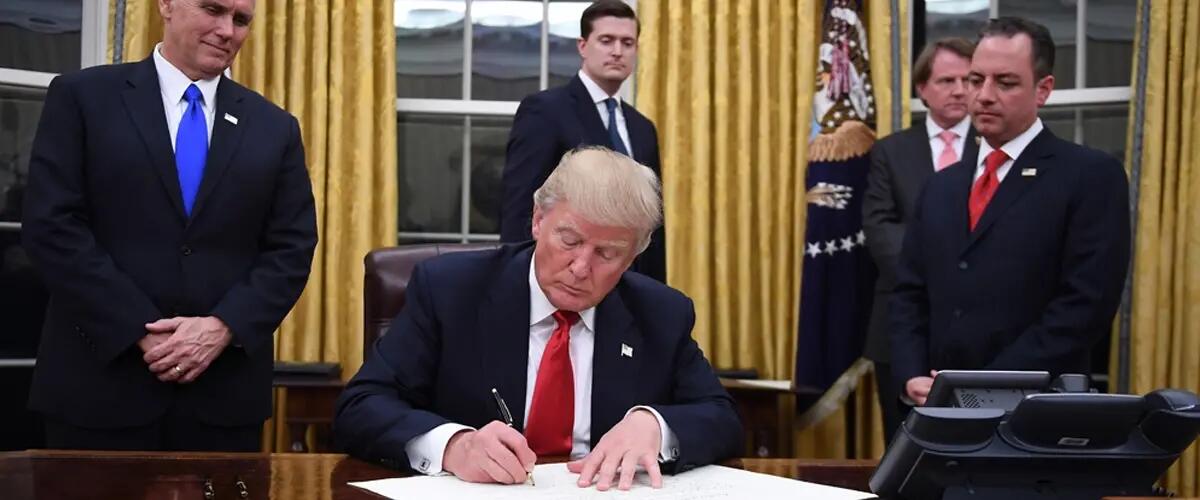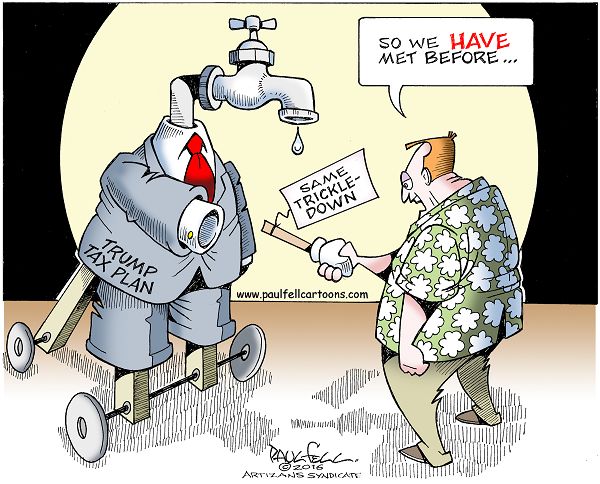
Supply-side economic theory powers Trump tax plan
By Farrokh Langdana, Director, Executive MBA Program & Professor of Finance and Economics
Faculty Blog: http://www.business.rutgers.edu/faculty/farrokh-langdana
The Wall Street Journal published a gem in a Nov. 25, 2017, letter to Treasury Secretary Steven Mnuchin during the tax debate signed by nine economic heavy hitters that included two of the original supply-side theorists, Prof. Robert Barro from Harvard and Prof. John Taylor, from Stanford; Taylor was in the recent running for Fed Chairman.
The WSJ article (A) is vintage supply-side thinking. Below is an overview of the supply-siders followed by analysis of two anti-supply side articles from Paul Krugman (B) of the New York Times and Peter Coy (C), the economics editor for Bloomberg Businessweek, followed by my personal opinion.
There are three fundamental 'pillars' of the supply-side model:
- Large business tax cuts are supposed to increase labor demand. (Please see figure 4a of Chapter 10, of my Book 4, Macroeconomic Policy, Edition 3. Read from 10.2)
- Large personal tax cuts are supposed to increase labor supply (figure 4b). With the ensuing increases in labor demand and supply, employment is consequently supposed to increase (see figure 7).
- Deregulation of intrusive government is supposed to increase productivity (figure 6) and that, plus the unfettered business eco-climate is supposed to drive Innovation.
As the "size of the pie" – the national income, denoted as Y---increases, tax revenues (T) are supposed to rise, in T = tY, where t is the % tax rate, Y is National Income (GDP) and T is Tax Revenues in dollars.
So as tax rates, t, fall with Trump's proposal, if Y (GDP, the size of the pie), increases disproportionately as per the S-side model in Figure 7, then the dollar tax revenues, T (the "tax base) may actually increase or, at least remain the same. In these cases, we get the refrain, “the Trump tax cuts will pay for themselves!”
Not so fast! say the critics, and most notably, the bane of the Supply-Siders, Prof. Krugman below, in "Lies, Lies, Lies....!" Krugman’s blog and the one from Bloomberg Businessweek’s economics editor following it (which actually responds to the WSJ article), presented below, argue that: No. It is not clear that the tax cuts to businesses and personal income actually affect labor demand and supply. The evidence does not support this, they claim. In fact, in a recent meeting of Top 50 CEOs only two out of 50 told a Trump cabinet minister, Gary Cohn, that they would increase employment if given juicy corporate tax cuts. Most of the tax cuts would, according to them, show up in greater earnings for their stock-holders.
And, critics would argue further that overall tax revenues, T, have not empirically increased in past supply-side experiments. There is no "increasing of the size of the pie to allow tax cuts to pay for themselves!" Please do click on the links below for the plots, charts, etc.
So, what do I think?
My response – and this is a personal thing and you are not obliged to agree with me. I have stayed away from gory detail and just presented broad-brush strokes here.
Yes, tax reform on the business side is necessary as small and medium businesses have indeed been hurting, and Yes, less invasive regulation is needed as we (the Obamists, actually) might have gone overboard with excessive regulation after the Great Recession of 2007.
But tax reform should not be a giveaway for Trump and his 1%. It cannot be a Welfare Plan for Billionaires. And tax reform should coincide with the outright removal of the existing loopholes that already result in effective corporate taxes actually being so much lower than statutory taxes.
For example, very few companies actually pay the 40% repatriation tax – it is really an “effective tax rate” of 22% which most corporations pay given the loopholes and exemptions. Our effective tax rate is still higher than Ireland, etc, but not that much higher!
From The New York Times, "Profitable Companies, No Taxes: Here’s How They Did It:" (https://www.nytimes.com/2017/03/09/business/economy/corporate-tax-report.html)
"Although the top corporate rate is 35 percent, hardly any company actually pays that. The report, by the Institute on Taxation and Economic Policy...found that 100 of them—nearly 40 percent — paid no taxes in at least one year between 2008 and 2015. Eighteen, including General Electric, International Paper, Priceline.com and PG&E, incurred a total federal income tax bill of less than zero over the entire eight-year period—meaning they received rebates. The institute used the companies’ own regulatory filings to compute their tax rates.”
Supply-side economics might be better applied to specific sectors such as IT innovation, alternate fuel innovation, robotics, etc., than carte blanche, across the economy.
The danger is that a liquidity trap may still exist. Companies are already flush with cash, so what if the lower taxes don’t excite them just as low interest rates did not? Then what? Then we may have a monster deficit non-sustainability issue as the Federal budget deficits lurch out of control.
This in turn may yield the standard Congressional response – a decrease in government spending, and an increase in taxes a la The Great Depression. In fact, if deficits hit some upper bound, then automatic tax hikes may already be baked into the current proposal! This might tank the economy. In fact, this may be the “poison pill” that might have been inadvertently embedded into this tax package.
(A) Here is letter by the Hard-Core, Founding Father, Supply-siders:
https://www.wsj.com/articles/how-tax-reform-will-lift-the-economy-1511729894
(B) And this from Krugman, the patron saint of the Anti-Supply Siders:
https://krugman.blogs.nytimes.com/2017/10/14/lies-lies-lies-lies-lies-lies-lies-lies-lies-lies/
(C) And then this gem in Bloomberg responds to the WSJ article:
https://www.bloomberg.com/news/articles/2017-11-30/the-best-way-to-spur-growth-help-the-poor-not-the-rich
C-bar up, everyone – the giant fruit cakes are now back in Costco, and my Chia Pet commercial is back on TV. So all is well. Happy Holidays!
Note: C-bar refers to consumer confidence, so when confidence (C-bar) goes up, consumption goes up, and private consumption in the US is 70% of the size of the economy.

Press: For all media inquiries see our Media Kit


